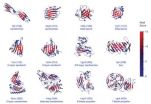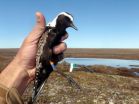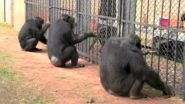(Press-News.org) The use of nanoparticles in cancer research is considered as a promising approach in detecting and fighting tumour cells. The method has, however, often failed because the human immune system recognizes the particles as foreign objects and rejects them before they can fulfil their function. Researchers at the Helmholtz-Zentrum Dresden-Rossendorf (HZDR) and at University College Dublin in Ireland have, along with other partners, developed nanoparticles that not only bypass the body's defence system, but also find their way to the diseased cells. This procedure uses fragments from a particular type of antibody that only occurs in camels and llamas. The small particles were even successful under conditions which are very similar to the situation within potential patients' bodies.
Describing the current state of research, Dr. Kristof Zarschler of the Helmholtz Virtual Institute NanoTracking at the HZDR explains, "At the moment we must overcome three challenges. First, we need to produce the smallest possible nanoparticles. We then need to modify their surface in a way that the proteins in the human bodies do not envelop them, which would thus render them ineffective. In order to ensure, that the particles do their job, we must also somehow program them to find the diseased cells." Therefore, the Dresden and Dublin researchers combined expertise to develop nanoparticles made of silicon dioxide with fragments of camel antibodies.
In contrast to conventional antibodies, which consist of two light and two heavy protein chains, those taken from camels and llamas are less complex and are made up of only two heavy chains. "Due to this simplified structure, they are easier to produce than normal antibodies," explains Zarschler. "We also only need one particular fragment – the portion of the molecule that binds to certain cancer cells – which makes the production of much smaller nanoparticles possible." By modifying the surface of the nanoparticle, it also gets more difficult for the immune system to recognize the foreign material, which allows the nanoparticles to actually reach their target.
The ultra-small particles should then detect the so-called epidermal growth factor receptor (EGFR) in the human body. In various types of tumours, this molecule is overexpressed and/or exists in a mutated form, which allows the cells to grow and multiply uncontrollably. The Dresden researchers could demonstrate in experiments that nanoparticles that have been combined with the camel antibody fragments can more firmly bind to the cancer cells. "The EGFR is a virtual lock to which our antibody fits like a key," explains Zarschler.
They even obtained the same results in experiments involving human blood serum – a biologically relevant environment the scientists point out: "This means that we carried out the tests under conditions that are very similar to the reality of the human body," explains Dr. Holger Stephan, who leads the project. "The problem with many current studies is that artificial conditions are chosen where no disruptive factors exist. While this provides good results, it is ultimately useless because the nanoparticles fail finally in experiments conducted under more complex conditions. In our case, we could at least reduce this error source."
However, more time is required before the nanoparticles can be utilized in diagnosing human tumours. "The successful tests have brought us one step further," explains Stephan. "The road, however, to its clinical use is long." The next aim is to reduce the size of the nanoparticles, which are now approximately fifty nanometres in diameter, to less than ten nanometres. "That would be optimal," according to Zarschler. "Then they would only remain in the human body for a short period – just long enough to detect the tumour."
INFORMATION:
Antibodies from the desert as guides to diseased cells
2014-06-12
ELSE PRESS RELEASES FROM THIS DATE:
Proliferation cues 'natural killer' cells for job change
2014-06-12
PROVIDENCE, R.I. [Brown University] —The immune system maintains a rich abundance of "natural killer" cells to confront microbial invaders, but as the body gains the upper hand in various infections it sometimes starts to produce even more of the cells. For three decades, scientists haven't understood what purpose that serves. In a new paper, Brown University researchers show one: proliferation helps change the NK cells' function from stimulating the immune response to calming it down, lest it get out of hand.
In a series of experiments now published online in the Journal ...
The transmission of information via proteins could revolutionize drug discovery
2014-06-12
Proteins are chains of amino acids that, when folded into certain structural patterns and also when unfolded, exert functions within cells. Proteins receive signals that are transmitted from one to the next and that are essential for life. However, within a given protein, are there "highways" along which the signals travel, like a in a relay event? That is to say, how is the information transmitted in a given protein? "This is one of the key questions in biophysics," says Xavier Salvatella, ICREA Professor at the Institute for Research in Biomedicine (IRB Barcelona) and ...
Tiny plants ride on the coattails of migratory birds
2014-06-12
Since the days of Darwin, biologists have questioned why certain plants occur in widely separated places, the farthest reaches of North American and the Southern tip of South America but nowhere in between. How did they get there? An international team of researchers have now found an important piece of the puzzle: migratory birds about to fly to South America from the Arctic harbor small plant parts in their feathers.
In the past several decades, scientists have discovered that the North – South distributions of certain plants often result from a single jump across the ...
Chimpanzees spontaneously initiate and maintain cooperative behavior
2014-06-12
VIDEO:
Chimpanzees spontaneously cooperate with multiple partners of their choosing to remove a barrier and pull in a tray baited with food.
Click here for more information.
Without any pre-training or restrictions in partner choice among chimpanzees, researchers at the Yerkes National Primate Research Center, Emory University, found for the first time that chimpanzees housed in a socially complex, contained setting spontaneously cooperate with multiple partners of their choosing. ...
All men with gout should be routinely screened for erectile dysfunction
2014-06-12
A new study presented today at the European League Against Rheumatism Annual Congress (EULAR 2014) showed that erectile dysfunction (ED) is present in most men with gout and is frequently severe.1
In a survey of 201 men, 83 had gout, of whom a significantly greater proportion had ED (76%) compared with those patients without gout (52%) (p= 0.0007). Also, a significantly greater proportion of gout patients (43%) had severe ED compared with patients without gout (30%) (p=0.007).1
According to lead author Dr. Naomi Schlesinger, Chief, Division of Rheumatology and Professor ...
Potential anti-TNF response biomarker identified
2014-06-12
DNA methylation has been identified as a potential biomarker of response to etanercept and adalimumab in patients with rheumatoid arthritis (RA) according to preliminary results from one of the largest methylome-wide investigations of treatment response to anti-TNF therapies.1 These data, presented today at the European League Against Rheumatism Annual Congress (EULAR 2014), bring clinicians a step closer to being able to personalise a patient's treatment pathway.
Anti-TNF therapies have proved a huge advance for the treatment of rheumatoid arthritis and have transformed ...
Regular exercise beneficial in suppressing inflammation in rheumatic disease
2014-06-12
Research findings presented today at the European League Against Rheumatism Annual Congress (EULAR 2014) suggest that exercise transiently suppresses local and systemic inflammation, reinforcing the beneficial effects of exercise and the need for this to be regular in order to achieve clinical efficacy in rheumatic disease.
Chronic inflammation, swelling and pain in the joints characterise the more than 200 rheumatic diseases. Persistent inflammation over time can damage affected joints, but previous research has established that exercise can decrease joint inflammation ...
Cranial ultrasound may replace temporal artery biopsy in diagnosis of giant cell arteritis
2014-06-12
A new study presented for the first time today at the European League Against Rheumatism Annual Congress (EULAR 2014), shows that cranial ultrasound has a greater sensitivity than temporal artery biopsy,* and a comparable specificity in the diagnosis of Giant Cell Arteritis (GCA).1
Giant Cell Arteritis (GCA), a condition in which medium and large arteries mainly in the head and neck, become inflamed and narrowed, can cause blindness due to occlusion of the artery supplying the back of the eye. It is therefore essential that a prompt, accurate diagnosis of GCA is made ...
New study sheds light on what happens to 'cool' kids
2014-06-12
Teens who tried to act cool in early adolescence were more likely than their peers who didn't act cool to experience a range of problems in early adulthood, according to a new decade-long study. The study, by researchers at the University of Virginia, appears in the journal Child Development.
While cool teens are often idolized in popular media—in depictions ranging from James Dean's Rebel Without a Cause to Tina Fey's Mean Girls—seeking popularity and attention by trying to act older than one's age may not yield the expected benefits, according to the study.
Researchers ...
Toddlers whose parents use subsidies to buy center-based care more likely to enroll in Head Start
2014-06-12
Children of parents who use subsidies to purchase center-based care in the toddler years are more likely to be enrolled in Head Start or public prekindergarten in their preschool years, according to a new study. The research, conducted at Georgetown University and Columbia University, appears in the journal Child Development.
The federally funded child care subsidy program—the Child Care and Development Fund (CCDF)—serves nearly 2 million children a month and is one of the government's biggest investments in the early care and education of low-income children. While the ...



